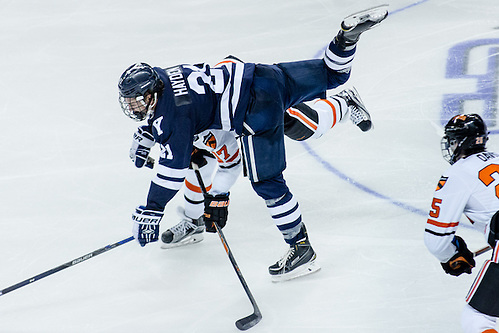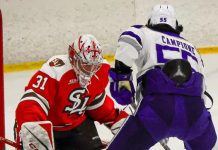
Each week during the season, we look at the big events and big games around Division I men’s college hockey in Tuesday Morning Quarterback.
Paula: Thanksgiving weekend is always a bit unusual for college hockey. Every division is fully engaged in conference play going into that weekend with the exception of the Big Ten and for the most part, the Thanksgiving holiday brings a lot of nonconference play. This year, the weekend’s games seem to have resulted in some interesting movement in the poll, especially for teams that didn’t even play. Penn State, Ohio State and Western Michigan all climbed in the poll even though they had the weekend off, for example. This leaves me wondering if voters are beginning to have a better perspective of the overall field and not just reacting to weekly results.
Frankly, I’m surprised that Bemidji State only dropped three spots after being swept by Princeton, while both North Dakota and Michigan each dropped four spots after splitting at home, the Fighting Hawks with Michigan State and the Wolverines with Lake Superior State. For these last two, the resulting drop seems to be as much a comment about the strength of their specific opponent this weekend as about the progress of the teams that split at home.
Jim: I’m still not ready to say that the voters in the poll have a better feel for anything, though I do feel in many cases this week voters looked at team’s overall records when casting their votes. Teams with records around .500 like St. Cloud State and Michigan both fell in the poll. So it’s possible that because there were a limited number of games last weekend, voters were paying attention to records as opposed to simply reacting to results from the previous weekend.
That said, one of the team’s that was successful on the ice, Denver, with wins against Air Force and Wisconsin, wasn’t able to make much progress sitting at No. 2. Top-ranked Minnesota-Duluth was idle and it seems voters didn’t feel it fair to shift their first-place vote from the Bulldogs to the Pioneers, despite the two wins. In fact, only one voter shifted from UMD to Denver and Denver’s point total in the poll increased just two votes total.
Next weekend is yet another bye week for Duluth at this point in the season (though UMD did play on the first possible day this year, the weekend most teams played their exhibition). Denver will face Colorado College with the opportunity to extended its unbeaten streak to 14 games and, if successful, will take that streak into a two-game series against Duluth.
Series between No. 1 and No. 2 have been rare since the USCHO.com poll started, but if Denver and UMD holds those spots next weekend, we’ll be looking at the second time this season where the top two teams meet.
Paula: And that, in many ways, is very exciting to see for every fan of Division I, but the strength of both Denver and UMD is also an indication of how strong the NCHC is again this season – how strong, at least, that the voters perceive that conference to be. I know that when I cast my ballot, I find myself looking at what I perceive to be the relative strength within a conference for some teams, even when they’re not playing within their own conferences.
I think that’s what we saw with Western Michigan moving up a couple of spots this week even though the Broncos weren’t playing. As voters’ confidence in the overall NCHC improves, so does their confidence in its individual teams, even when those teams seem to be in need of proving themselves. Same goes for the Nittany Lions and the Buckeyes, two teams that may be very good this season but are having to overcome both individual and conference history to gain the confidence of voters.
Switching gears to some individual results for the weekend, were you surprised by anything that transpired over the weekend? You correctly called Minnesota’s trip east, with a loss to Northeastern and win over Boston College. I didn’t think that Bemidji State would drop two to Princeton, but I was really surprised to see Michigan State win and tie in North Dakota.
Jim: I think the biggest surprise for me was Princeton’s two game sweep of Bemidji State. We talked the last couple of weeks about the fact that it is early to put a whole lot of stock in the PairWise, but if you just take those PairWise numbers, Bemidji State entered the weekend 2nd in the PairWise and Princeton was 60th out of 60 teams. So whether or not the PairWise is 100 percent reliable right now, that two-game sweep was one heck of an upset.
Another, for me at least, was Vermont win in Belfast over Quinnipiac to capture the Belpot Trophy. Vermont was nearly done in for four minutes in that tournament when it fell behind 2-0 to Massachusetts. But a four-goal rally in that game and a dominating 5-1 victory over Quinnipiac helped earn to tournament title.
Which brings me to the topic of in-season tournaments and this is a topic that pops up every now and again, particularly at this time of year. Quinnipiac advanced to the championship game without scoring a goal. A scoreless tie against St. Lawrence was decided by a shootout goal. The same happened to advance Clarkson to the championship game of the Shillelagh Tournament at Notre Dame, a tournament they ended up winning.
Maybe it’s the hockey purist in me that doesn’t enjoy these shootouts to decide in-season tournaments. I know coaches don’t love playing long games during the regular season and the potential for a double- or triple-overtime games. But I’ve also had coaches tell me that the reason they play in-season tournaments is to simulate scenarios that they may encounter in the post-season (survive and advance scenarios, often non-traditional game times, etc.).
So I ask, do you favor using a shootout during the tournaments or would you prefer to watch sudden death overtime as long as it takes to decide a winner?
Paula: Everyone who’s ever heard me pontificate about the shootout knows how much I hate it in regular-season play. I like the idea of teams being able to play to a genuine tie at the end of an overtime period. That is an accurate representation, then, of that specific game.
When it comes to in-season tournaments, though, I’m really torn – and I’m sure that surprises a lot of people. Like you, I’m a hockey purist and it’s pretty amazing that a team can advance to a title game in an in-season tournament without having scored a legitimate goal in the tournament’s semifinal game. I can understand how coaches would be concerned by games that can drag on and on, especially since the subsequent game counts in the PairWise, when one team may have played three periods of regulation and another played significantly longer in their respective previous games.
Maybe that third option is playing with fewer players in OT in order to provide more opportunity for overtime goal scoring.
Speaking of fluky outcomes, I’ve been looking at some things that appear on the surface to be statistical anomalies. Granted, we aren’t midway through the season, but a quick look at, say, the goaltenders who are among the top 20 shows only a few playing for teams that are currently under consideration in the PWR and a few goaltenders that are having good seasons that are playing for teams that are not performing consistently well in front of them. Then there are players like Union’s Mike Vecchione with his 14 overall goals or Yale’s John Hayden with his six power-play goals and I’m reminded of how increasingly Division I hockey is a team sport, that the days of a single team being able to rely on a great goaltender or even a hot line to take them especially far be gone.
Are there specific teams, then, that are impressing you with their overall efforts? I’d put St. Lawrence in that category, a team that may be a sleeper this year, with 18 guys who have scored at least one goal and no one that is a nationwide household name.
Jim: I think I can target Western Michigan again as a team that certainly has a top-tier player in Matheson Iacopelli, but also has a lot of depth offensively. The Broncos had 15 different goal scorers and 24 players who have recorded points (not to mention 28 different players who have dressed). My guess is that every night for Andy Murray it is a difficult decision which 18 skaters should wear the jersey. The Broncos have also gotten wins from three different goaltenders, and though Trevor Gorsuch has carried the water for Western, you have to think that Murray has other choices in net should he need them.
Thumbs Up/Thumbs Down
Thumbs up to Minnesota coach Don Lucia who, with a 4-2 road win against Boston College on Sunday, became just the eight coach in college hockey to record 700 career wins. Lucia did plenty to rebuild Alaska in the late ’80s and early ’90s and then produced six straight 20+ win campaigns (two were 30+). He also coached at Colorado College.
And that is all before he got to Minnesota. Since taking over the Gophers in 1999, Lucia has missed the NCAA tournament just five times. His Gopher teams have reached the Frozen Four five times and, of course, he coached two national champions in 2002 and 2003. Congrats, Coach!
We have to give the thumbs down to the four games of the Friendship Four. Not because they weren’t all excellent games, and certainly not because of the incredible tournament that was run by the organizers. But the reality is that in each of the four games, there was a bad hit by one team resulting in a major penalty (St. Lawrence, for the record, was responsible for two, UMass had none). Three of those majors also included game misconducts. Not a lot of “friendship” when it came to play on the ice. We get it. Battling for a trophy can turn physical. But it seemed there were a lot of dangerous hits that everyone wants to get out of the game.


